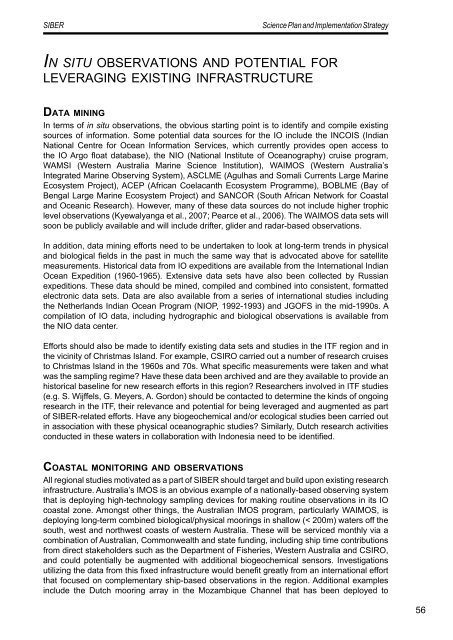SIBER SPIS sept 2011.pdf - IMBER
SIBER SPIS sept 2011.pdf - IMBER
SIBER SPIS sept 2011.pdf - IMBER
You also want an ePaper? Increase the reach of your titles
YUMPU automatically turns print PDFs into web optimized ePapers that Google loves.
<strong>SIBER</strong><br />
Science Plan and Implementation Strategy<br />
In s i t u o b s e r v a t i o n s a n d p o t e n t i a l f o r<br />
l e v e r a g i n g e x i s t i n g i n f r as t r u c t u r e<br />
Dat a mi n i n g<br />
In terms of in situ observations, the obvious starting point is to identify and compile existing<br />
sources of information. Some potential data sources for the IO include the INCOIS (Indian<br />
National Centre for Ocean Information Services, which currently provides open access to<br />
the IO Argo float database), the NIO (National Institute of Oceanography) cruise program,<br />
WAMSI (Western Australia Marine Science Institution), WAIMOS (Western Australia’s<br />
Integrated Marine Observing System), ASCLME (Agulhas and Somali Currents Large Marine<br />
Ecosystem Project), ACEP (African Coelacanth Ecosystem Programme), BOBLME (Bay of<br />
Bengal Large Marine Ecosystem Project) and SANCOR (South African Network for Coastal<br />
and Oceanic Research). However, many of these data sources do not include higher trophic<br />
level observations (Kyewalyanga et al., 2007; Pearce et al., 2006). The WAIMOS data sets will<br />
soon be publicly available and will include drifter, glider and radar-based observations.<br />
In addition, data mining efforts need to be undertaken to look at long-term trends in physical<br />
and biological fields in the past in much the same way that is advocated above for satellite<br />
measurements. Historical data from IO expeditions are available from the International Indian<br />
Ocean Expedition (1960-1965). Extensive data sets have also been collected by Russian<br />
expeditions. These data should be mined, compiled and combined into consistent, formatted<br />
electronic data sets. Data are also available from a series of international studies including<br />
the Netherlands Indian Ocean Program (NIOP, 1992-1993) and JGOFS in the mid-1990s. A<br />
compilation of IO data, including hydrographic and biological observations is available from<br />
the NIO data center.<br />
Efforts should also be made to identify existing data sets and studies in the ITF region and in<br />
the vicinity of Christmas Island. For example, CSIRO carried out a number of research cruises<br />
to Christmas Island in the 1960s and 70s. What specific measurements were taken and what<br />
was the sampling regime Have these data been archived and are they available to provide an<br />
historical baseline for new research efforts in this region Researchers involved in ITF studies<br />
(e.g. S. Wijffels, G. Meyers, A. Gordon) should be contacted to determine the kinds of ongoing<br />
research in the ITF, their relevance and potential for being leveraged and augmented as part<br />
of <strong>SIBER</strong>-related efforts. Have any biogeochemical and/or ecological studies been carried out<br />
in association with these physical oceanographic studies Similarly, Dutch research activities<br />
conducted in these waters in collaboration with Indonesia need to be identified.<br />
Coa s t a l mo n i t o r i n g an d ob s e r v a t i o n s<br />
All regional studies motivated as a part of <strong>SIBER</strong> should target and build upon existing research<br />
infrastructure. Australia’s IMOS is an obvious example of a nationally-based observing system<br />
that is deploying high-technology sampling devices for making routine observations in its IO<br />
coastal zone. Amongst other things, the Australian IMOS program, particularly WAIMOS, is<br />
deploying long-term combined biological/physical moorings in shallow (< 200m) waters off the<br />
south, west and northwest coasts of western Australia. These will be serviced monthly via a<br />
combination of Australian, Commonwealth and state funding, including ship time contributions<br />
from direct stakeholders such as the Department of Fisheries, Western Australia and CSIRO,<br />
and could potentially be augmented with additional biogeochemical sensors. Investigations<br />
utilizing the data from this fixed infrastructure would benefit greatly from an international effort<br />
that focused on complementary ship-based observations in the region. Additional examples<br />
include the Dutch mooring array in the Mozambique Channel that has been deployed to<br />
56












